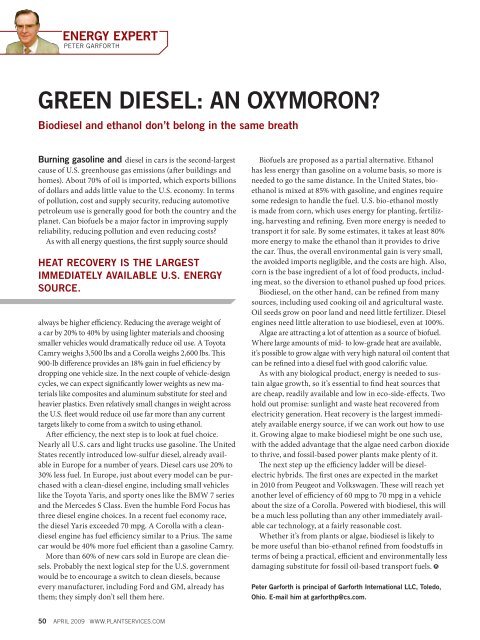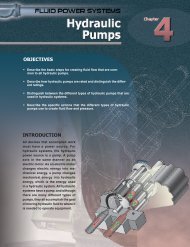POWER UP A WINNER - Plant Services
POWER UP A WINNER - Plant Services
POWER UP A WINNER - Plant Services
Create successful ePaper yourself
Turn your PDF publications into a flip-book with our unique Google optimized e-Paper software.
energy exPErt<br />
peter garforth<br />
GrEEn DIEsEL: An Oxymoron<br />
Biodiesel and ethanol don’t belong in the same breath<br />
Burning gasoline and diesel in cars is the second-largest<br />
cause of U.S. greenhouse gas emissions (after buildings and<br />
homes). About 70% of oil is imported, which exports billions<br />
of dollars and adds little value to the U.S. economy. In terms<br />
of pollution, cost and supply security, reducing automotive<br />
petroleum use is generally good for both the country and the<br />
planet. Can biofuels be a major factor in improving supply<br />
reliability, reducing pollution and even reducing costs<br />
As with all energy questions, the first supply source should<br />
HEAT rECOvery is THE LArGEst<br />
immEDIATELy avAILABLE U.S. energy<br />
sOUrCE.<br />
always be higher efficiency. Reducing the average weight of<br />
a car by 20% to 40% by using lighter materials and choosing<br />
smaller vehicles would dramatically reduce oil use. A Toyota<br />
Camry weighs 3,500 lbs and a Corolla weighs 2,600 lbs. This<br />
900-lb difference provides an 18% gain in fuel efficiency by<br />
dropping one vehicle size. In the next couple of vehicle-design<br />
cycles, we can expect significantly lower weights as new materials<br />
like composites and aluminum substitute for steel and<br />
heavier plastics. Even relatively small changes in weight across<br />
the U.S. fleet would reduce oil use far more than any current<br />
targets likely to come from a switch to using ethanol.<br />
After efficiency, the next step is to look at fuel choice.<br />
Nearly all U.S. cars and light trucks use gasoline. The United<br />
States recently introduced low-sulfur diesel, already available<br />
in Europe for a number of years. Diesel cars use 20% to<br />
30% less fuel. In Europe, just about every model can be purchased<br />
with a clean-diesel engine, including small vehicles<br />
like the Toyota Yaris, and sporty ones like the BMW 7 series<br />
and the Mercedes S Class. Even the humble Ford Focus has<br />
three diesel engine choices. In a recent fuel economy race,<br />
the diesel Yaris exceeded 70 mpg. A Corolla with a cleandiesel<br />
engine has fuel efficiency similar to a Prius. The same<br />
car would be 40% more fuel efficient than a gasoline Camry.<br />
More than 60% of new cars sold in Europe are clean diesels.<br />
Probably the next logical step for the U.S. government<br />
would be to encourage a switch to clean diesels, because<br />
every manufacturer, including Ford and GM, already has<br />
them; they simply don’t sell them here.<br />
Biofuels are proposed as a partial alternative. Ethanol<br />
has less energy than gasoline on a volume basis, so more is<br />
needed to go the same distance. In the United States, bioethanol<br />
is mixed at 85% with gasoline, and engines require<br />
some redesign to handle the fuel. U.S. bio-ethanol mostly<br />
is made from corn, which uses energy for planting, fertilizing,<br />
harvesting and refining. Even more energy is needed to<br />
transport it for sale. By some estimates, it takes at least 80%<br />
more energy to make the ethanol than it provides to drive<br />
the car. Thus, the overall environmental gain is very small,<br />
the avoided imports negligible, and the costs are high. Also,<br />
corn is the base ingredient of a lot of food products, including<br />
meat, so the diversion to ethanol pushed up food prices.<br />
Biodiesel, on the other hand, can be refined from many<br />
sources, including used cooking oil and agricultural waste.<br />
Oil seeds grow on poor land and need little fertilizer. Diesel<br />
engines need little alteration to use biodiesel, even at 100%.<br />
Algae are attracting a lot of attention as a source of biofuel.<br />
Where large amounts of mid- to low-grade heat are available,<br />
it’s possible to grow algae with very high natural oil content that<br />
can be refined into a diesel fuel with good calorific value.<br />
As with any biological product, energy is needed to sustain<br />
algae growth, so it’s essential to find heat sources that<br />
are cheap, readily available and low in eco-side-effects. Two<br />
hold out promise: sunlight and waste heat recovered from<br />
electricity generation. Heat recovery is the largest immediately<br />
available energy source, if we can work out how to use<br />
it. Growing algae to make biodiesel might be one such use,<br />
with the added advantage that the algae need carbon dioxide<br />
to thrive, and fossil-based power plants make plenty of it.<br />
The next step up the efficiency ladder will be dieselelectric<br />
hybrids. The first ones are expected in the market<br />
in 2010 from Peugeot and Volkswagen. These will reach yet<br />
another level of efficiency of 60 mpg to 70 mpg in a vehicle<br />
about the size of a Corolla. Powered with biodiesel, this will<br />
be a much less polluting than any other immediately available<br />
car technology, at a fairly reasonable cost.<br />
Whether it’s from plants or algae, biodiesel is likely to<br />
be more useful than bio-ethanol refined from foodstuffs in<br />
terms of being a practical, efficient and environmentally less<br />
damaging substitute for fossil oil-based transport fuels.<br />
Peter Garforth is principal of Garforth International LLC, Toledo,<br />
Ohio. E-mail him at garforthp@cs.com.<br />
50 APRIL 2009 www.PLANTSERVICES.com












